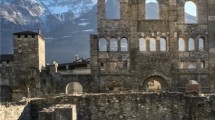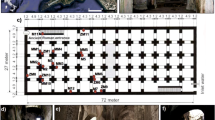Abstract
This study shows the results of a multidisciplinary collaboration between the University of Calabria (Italy) and the National Autonomous University of Mexico (UNAM), about the compositional characterization of some mortars taken from Hagia Sophia in Istanbul (Turkey), one of the most important buildings in antiquity. Twenty samples of joint mortars were analysed by micro-chemical analyses (SEM-EDS), X-ray powder diffraction (XRPD), optical microscopy (OM) and transmission electron microscopy (TEM). The compositional study allowed us to define, with more detail, the construction phases of the fifth, sixth and tenth century. The petrographic analysis in thin section by optical microscopy showed four typologies of sands, used as aggregate, with specific compositional features. SEM-EDS analyses and TEM observations of the binder around the ceramic fragments of the aggregate showed the presence of different morphologies of single C-S-H compounds.










Similar content being viewed by others
References
Aitchison J (1982) The statistical analysis of compositional data (with discussion. J R Stat Soc Series B 44:139–177
Aitchison J (1983) The principal component analysis of compositional data. Biometrika 70:57–65
Aitchison J (1986) The statistical analysis of compositional data. In: Monographs on Statistics and Applied Probability. Chapman & Hall Ltd, London Reprinted (2003) with Additional Material by The Blackburn Press, Caldwell, NJ
Barba L, Blancas J, Manzanilla LR, Ortiz A, Barca D, Crisci GM, Miriello D, Pecci A (2009) Provenance of the limestone used in Teotihuacan (Mexico): a methodological approach. Archaeometry 51:525–545
Barba L, Blancas J, Pecci A, Miriello D, Cura M, Crisci GM, Cappa M, De Angelis D, Yavuz HB (2016) Georadar investigations in the central nave of Hagia Sofia, Istanbul (Turkey). Archaeol Anthropol Sci. doi:10.1007/s12520-016-0351-y
Boggs S Jr (2010) Petrology of sedimentary rocks, 2nd edn. Cambridge University Press, Cambridge
Boynton RS (1966) Chemistry and technology of lime and limestone. Wiley, New York
Çakmak AŞ, Moropoulou A, Mullen CL (1995) Interdisciplinary study of dynamic behaviour and earthquake response of Hagia Sophia. Soil Dyn Earthq Eng 14:125–133
Cappa M, De Angelis D, Pecci A, Barba L, Cura M, Crisci GM, Blancas J, Yavuz HB, Miriello D (2016) Thermographic survey at Hagia Sophia: main arches, pendentives and tympana. Int J Archit Herit. doi:10.1080/15583058.2015.1104400
Carò F, Riccardi MP, Mazzilli Savini MT (2008) Characterization of plasters and mortars as a tool in archaeological studies: the case of Lardirago Castle in Pavia, Northern Italy. Archaeometry 50:85–100
Chiarelli N, Miriello D, Bianchi G, Fichera G, Giamello M, Memmi IT (2016) Characterisation of ancient mortars from the S. Niccolò archaeological complex in Montieri (Tuscany - Italy. Constr Build Mater 96:442–460
Crisci GM, Franzini M, Lezzerini M, Mannoni T, Riccardi MP (2004) Ancient mortars and their binder. Period Mineral 73:259–268
Cura M (2016) Costruzione di un database GIS 3D per un approccio multidisciplinare alla diagnostica di Santa Sofia (Istanbul - Turchia). PhD thesis, Calabria University, Department of Biology, Ecology and Earth Sciences, Arcavacata di Rende (CS –Itay)
Cura M, Pecci A, Miriello D, Barba L, Cappa M, De Angelis D, Blancas J, Crisci GM (2014) Multi-analytical approach for the diagnostic at Hagia Sophia: a 3D multimedia database proposal. Annual of Hagia Sophia Museum 14:379–403
Cura M (2010) Tani Yontemleri uygulanilarak gerçeklestirilmis 2002–2003 konservasyon çalismalari. Annual of Hagia Sofia Museum 13:280–293
Damiani D, Gliozzo E, Memmi I, Turbanti I, Spangenberg JE (2003) Pigments and plasters discovered in the house of Diana (Cosa, Grosseto, Italy): an integrated study between art history, archaeology and scientific analyses. Archaeometry 45:341–354
De Luca R, Cau Ontiveros MA, Miriello D, Pecci A, Le Pera E, Bloise A, Crisci GM (2013) Archaeometric study of mortars and plasters from the Roman City of Pollentia (Mallorca-Balearic Islands). Period Mineral 82(3):353–379
De Luca R, Gigliotti V, Panarello M, Bloise A, Crisci GM, Miriello D (2016) Spectroscopic, microchemical and petrographic analyses of plasters from ancient buildings in Lamezia Terme (Calabria, Southern Italy. Spectrochim Acta A 153:184–193
De Luca R, Miriello D, Pecci A, Domínguez-Bella S, Bernal-Casasola D, Cottica D, Bloise A, Crisci GM (2015) Archaeometric study of mortars from the Garum Shop at Pompeii, Campania, Italy. Geoarchaeology 30:330–351
Dekayir A, Amouric M, Olives J, Parron C, Nadiri A, Chergui A, El Hajraoui MA (2004) Structure et caractérisation des matériaux utilisés dans la construction d’une mosaïque romaine de la cité de Volubilis (Maroc. Compt Rendus Geosci 336:1061–1070
Franzini M, Leoni L, Lezzerini M (2000b) A procedure for determining the chemical composition of binder and aggregate in ancient mortars: its application to mortars from some medieval buildings in Pisa. J Cult Herit 1:365–373
Franzini M, Leoni L, Lezzerini M, Sartori F (1999) On the binder of some ancient mortars. Mineral Petrol 67:59–69
Franzini M, Leoni L, Lezzerini M, Sartori F (2000a) The mortar of the “Leaning Tower” of Pisa: the product of a medieval technique for preparing high-strength mortars. Eur J Mineral 12:1151–1163
Jerram DA (2001) Visual comparators for degree of grain-size sorting in two and three-dimensions. Comput Geosci 27:485–492
Kramar S, Zalar V, Urosevic M, Körner W, Mauko A, Mirtič B, Lux J, Mladenović A (2011) Mineralogical and microstructural studies of mortars from the bath complex of the Roman villa rustica near Mošnje (Slovenia). Mater Char 62(11):1042–1057
Lezzerini M, Legnaioli S, Lorenzetti G, Palleschi V, Tamponi M (2014b) Characterization of historical mortars from the bell tower of St. Nicholas church (Pisa, Italy. Constr Build Mater 69:203–212
Lezzerini M, Tamponi M, Bertoli M (2013) Reproducibility, precision and trueness of X-ray fluorescence data for mineralogical and/or petrographic purposes. Atti Soc Tosc Sci Nat, Mem, Serie A 120:67–73
Lezzerini M, Tamponi M, Bertoli M (2014a) Calibration of XRF data on silicate rocks using chemicals as in-house standards. Atti Soc Tosc Sci Nat, Mem, Serie A 121:65–70
Mainstone RJ (2009) Santa Sofia. Mondadori Electa, Milano
Miriello D, Crisci GM (2006) The image analysis and flatbed scanners. A visual procedure in order to study the macro-porosity of the archeological and historical mortars. J Cult Herit 7:186–192
Miriello D, Antonelli F, Apollaro C, Bloise A, Bruno N, Catalano M, Columbu S, Crisci GM, De Luca R, Lezzerini M, Mancuso S, La Marca A (2015b) A petro-chemical study of ancient mortars from the archaeological site of Kyme (Turkey). Period Mineral 84:497–517
Miriello D, Barca D, Bloise A, Ciarallo A, Crisci GM, De Rose F, Gattuso C, Gazineo F, La Russa MF (2010) Characterisation of archaeological mortars from Pompeii (Campania, Italy) and identification of construction phases by compositional data analysis. J Archaeol Sci 37:2207–2223
Miriello D, Barca D, Crisci GM, Barba L, Blancas J, Ortiz A, Pecci A, López Luján L (2011b) Characterization and provenance of lime plasters from the Templo Mayor of Tenochtitlan (Mexico City. Archaeometry 53:1119–1141
Miriello D, Barca D, Pecci A, De Luca R, Crisci GM, López Luján L, Barba L (2015a) Plasters from different buildings of the sacred precinct of Tenochtitlan (Mexico City): characterization and provenance. Archaeometry 1:100–127
Miriello D, Bloise A, Crisci GM, Apollaro C, La Marca A (2011a) Characterisation of archaeological mortars and plasters from Kyme (Turkey. J Archaeol Sci 38:794–804
Miriello D, Lezzerini M, Chiaravalloti F, Bloise A, Apollaro C, Crisci GM (2013) Replicating the chemical composition of the binder for restoration of historic mortars as an optimization problem. Comput Concr 12:553–563
Morales-Florez V, Findling N, Brunet F (2012) Changes on the nanostructure of cementitius calcium silicate hydrates (C-S-H) induced by aqueous carbonation. J Mater Sci 47:764–771
Moropoulou A, Polikreti K (2010) Studying the Hagia Sofia structural materials: the conservation of the national technical University of Athens to the monument’s protection. Annual Of Hagia Sofia Museum 13:155–176
Moropoulou A, Bakolas A, Bisbikou K (2000) Investigation of the technology of historic mortars. J Cult Herit 1:45–58
Moropoulou A, Cakmak AS, Biscontin G, Bakolas A, Zendri E (2002) Advanced Byzantine cement based composites resisting earthquake stresses: the crushed brick y lime mortars of Justinian’s Hagia Sophia. Constr Build Mater 16:543–552
Moropoulou A, Labropoulos K, Moundoulas P, Bakolas A (2006) The contribution of historic mortars on the earthquake resistance of Byzantine monuments. In: Konsta-Gdoutos MS (ed) Measuring, monitoring and modeling concrete properties. Springer, Netherlands, pp. 643–652
Myron Best G (2003) Igneous and metamorphic petrology, 2nd edn. Blackwell, Oxford
Necipoglu G (1992) The life of an imperial monument: Hagia Sophia after Byzantium. In: Mark R, Cakmak AS (eds) Hagia Sophia from the age of Justinian to the present. Cambridge University Press, Cambridge, pp. 195–225
Riccardi MP, Lezzerini M, Carò F, Franzini M, Messiga B (2007) Microtextural and microchemical studies of hydraulic ancient mortars: two analytical approaches to understand pre-industrial technology processes. J Cult Herit 8:350–360
Ricci Lucchi F (1980) Sedimentologia Parte I: Materiali e tessiture dei sedimenti. Clueb, Bologna
Silva J, De Brito J, Veiga R (2009) Incorporation of fine ceramics in mortars. Constr Build Mater 23:556–564
Taylor HFW (1997) Cement chemistry, 2nd edn. Thomas Telford, London, pp. 113–128
Wentworth CK (1922) A scale of grade and class terms for clastic sediments. J Geol 30:377–392
Acknowledgments
We would like to thank all the staff and the Direction of the Hagia Sophia Museum for their helpfulness and hospitality, as well as the Ministry of Culture of Turkey for the granting of all permits necessary to conduct investigations inside the monument. The work is part of the research activity of the Department of Biology, Ecology and Earth Sciences (DiBEST) of the University of Calabria, the Archaeological Prospection Laboratory, Universidad National Autónoma de México (UNAM), the Ramon y Cajal contract of A. Pecci RYC 2013-13369 and the ERAAUB (Consolidated Group 2014 SGR845) and was carried out within the framework of Murat Cura’s PhD thesis (2016). We would also like to thank Mariano Davoli, Ida Daniela Perrotta and Giancarlo Niceforo for their support on SEM-EDS, TEM and XRF analyses.
Author information
Authors and Affiliations
Corresponding author
Rights and permissions
About this article
Cite this article
Miriello, D., Barba, L., Blancas, J. et al. New compositional data on ancient mortars from Hagia Sophia (Istanbul, Turkey). Archaeol Anthropol Sci 9, 499–514 (2017). https://doi.org/10.1007/s12520-016-0375-3
Received:
Accepted:
Published:
Issue Date:
DOI: https://doi.org/10.1007/s12520-016-0375-3




